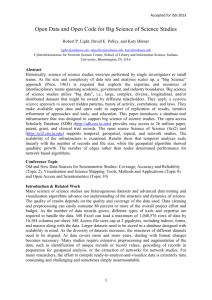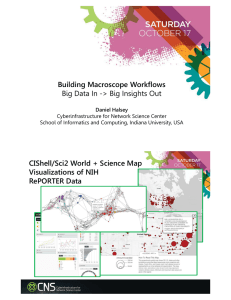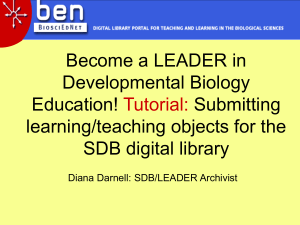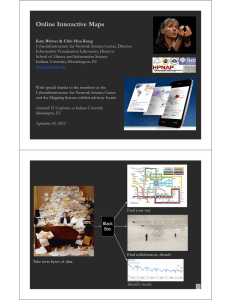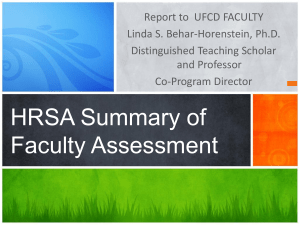Open Data and Open Code for Big Science of Science... Robert P. Light, David E. Polley, and Katy Börner Accepted for ISSI 2013
advertisement
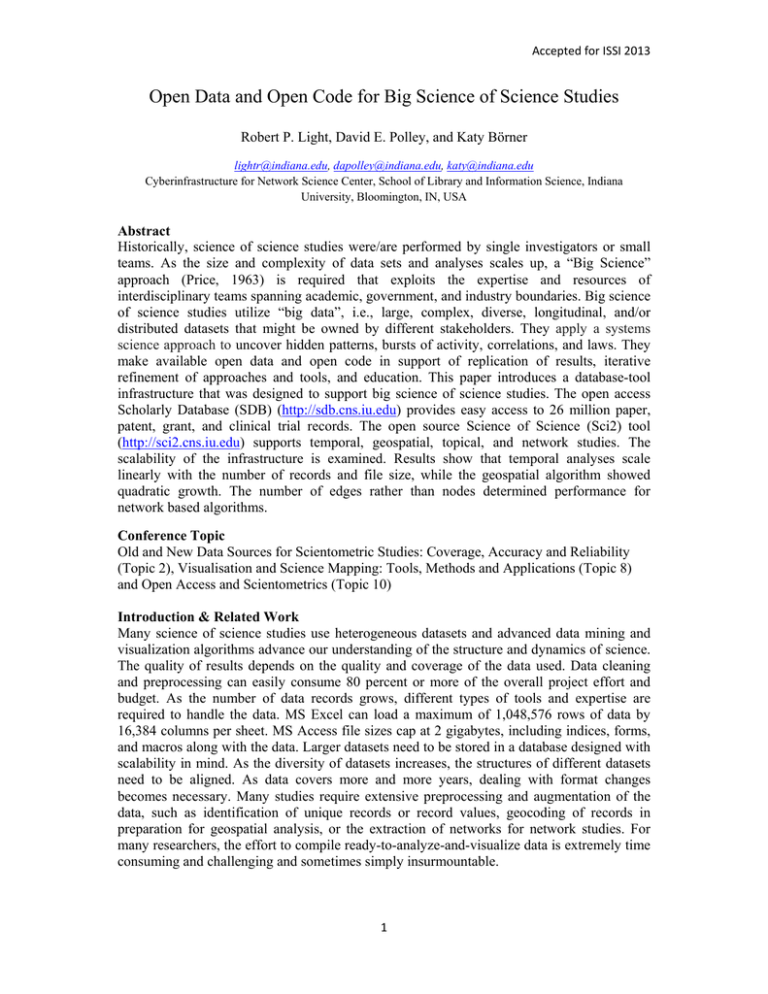
Accepted for ISSI 2013 Open Data and Open Code for Big Science of Science Studies Robert P. Light, David E. Polley, and Katy Börner lightr@indiana.edu, dapolley@indiana.edu, katy@indiana.edu Cyberinfrastructure for Network Science Center, School of Library and Information Science, Indiana University, Bloomington, IN, USA Abstract Historically, science of science studies were/are performed by single investigators or small teams. As the size and complexity of data sets and analyses scales up, a “Big Science” approach (Price, 1963) is required that exploits the expertise and resources of interdisciplinary teams spanning academic, government, and industry boundaries. Big science of science studies utilize “big data”, i.e., large, complex, diverse, longitudinal, and/or distributed datasets that might be owned by different stakeholders. They apply a systems science approach to uncover hidden patterns, bursts of activity, correlations, and laws. They make available open data and open code in support of replication of results, iterative refinement of approaches and tools, and education. This paper introduces a database-tool infrastructure that was designed to support big science of science studies. The open access Scholarly Database (SDB) (http://sdb.cns.iu.edu) provides easy access to 26 million paper, patent, grant, and clinical trial records. The open source Science of Science (Sci2) tool (http://sci2.cns.iu.edu) supports temporal, geospatial, topical, and network studies. The scalability of the infrastructure is examined. Results show that temporal analyses scale linearly with the number of records and file size, while the geospatial algorithm showed quadratic growth. The number of edges rather than nodes determined performance for network based algorithms. Conference Topic Old and New Data Sources for Scientometric Studies: Coverage, Accuracy and Reliability (Topic 2), Visualisation and Science Mapping: Tools, Methods and Applications (Topic 8) and Open Access and Scientometrics (Topic 10) Introduction & Related Work Many science of science studies use heterogeneous datasets and advanced data mining and visualization algorithms advance our understanding of the structure and dynamics of science. The quality of results depends on the quality and coverage of the data used. Data cleaning and preprocessing can easily consume 80 percent or more of the overall project effort and budget. As the number of data records grows, different types of tools and expertise are required to handle the data. MS Excel can load a maximum of 1,048,576 rows of data by 16,384 columns per sheet. MS Access file sizes cap at 2 gigabytes, including indices, forms, and macros along with the data. Larger datasets need to be stored in a database designed with scalability in mind. As the diversity of datasets increases, the structures of different datasets need to be aligned. As data covers more and more years, dealing with format changes becomes necessary. Many studies require extensive preprocessing and augmentation of the data, such as identification of unique records or record values, geocoding of records in preparation for geospatial analysis, or the extraction of networks for network studies. For many researchers, the effort to compile ready-to-analyze-and-visualize data is extremely time consuming and challenging and sometimes simply insurmountable. 1 Accepted for ISSI 2013 Many datasets relevant for science of science studies, e.g., papers, patents, grants, clinical trials, are freely available by different providers. However, they are stored in separate silos with diverse interfaces of varying usability that deliver data in many different formats. Research projects seeking to use one or many of these data sources face major data access, integration, and unification challenges. Indiana University’s Scholarly Database (SDB), originally launched in 2005, makes over 26 million scholarly records freely available via a unified interface and in data formats that are easy to use and well documented. In the last four years, SDB has answered thousands of queries and delivered millions of records to users around the globe. The 2012 update to the SDB improves the quality of data offered and integrates new humanities and clinical trial datasets. Equipped with high quality, high coverage data in standard data formats, tools that scale in terms of the number of records that can be read and processed are needed to truly make sense of big data (Robertson, Ebert, Eick et al., 2009). While most tools work well for micro and meso level studies (up to 100,000 records), few scale to macro level big-data studies with millions or even billions of records. Another type of scalability relates to the ease of usage and ease of interpretation of big data visualizations. How to best communicate temporal trends or burst of activity over a 100 year time span? How to depict the geospatial location of millions of records in a scalable fashion? Can the topical evolution of massive document datasets be communicated to a general audience? Most visualizations of million node networks resemble illegible spaghetti balls—do advanced network analysis algorithms scale and help to derive insights? Frequently, different types of analysis have to be applied to truly understand a natural, social, or technological system. Examples are temporal studies that answer WHEN questions, geospatial studies that answer WHERE questions and draw heavily on research in cartography, topical studies that use linguistic analysis to answer WHAT questions, and network studies that employ algorithms and techniques developed in social sciences, physics, information science and other domains to answer WITH WHOM questions. However, most existing systems support only one general type of analysis and visualization and many require programming skills. For example, four of the top 20 data visualization tools listed by .net in September of 2012 support charts and graphs while six support geospatial maps exclusively (Suda, 2012). Only the D3 (Data-Driven Documents) and Raphaël JavaScript libraries, the Google Chart API, and R support a larger array of charts, graphs, and maps yet all three require programming or scripting skills that most users do not possess. Excel might be the only tool on the list that can be used by a large number of non-programmers. A listing of tools commonly used in science of science studies can be found at http://sci2.wiki.cns.iu.edu/display/SCI2TUTORIAL/8.2+Network+Analysis+and+Other+Too ls but most support a very limited range of workflows (Cobo, López-Herrera, HerreraViedma et al., 2011). This paper presents a database-tool infrastructure that applies a divide-and-conquer approach to support big science of science studies. It combines an online database supporting bulk download of data in easy to process formats with a plug-and-play tool to read, clean, interlink, mine, and visualize data using easy to manipulate graphical user interfaces. The remaining paper is organized as follows: The next two sections present the database and tool functionalities. Subsequently, we test and discuss their scalability. We conclude the paper with a discussion of the presented work and an outlook to future work. 2 Accepted for ISSI 2013 The Scholarly Database (SDB) The Scholarly Database was created in 2005 to provide researchers and practitioners easy access to various datasets offered by different publishers and agencies (LaRowe, Ambre, Burgoon et al., 2009). The Scholarly Database is implemented using PostgreSQL 8.4, a free and open source relational database management system. Since the introduction of version 8.1, PostgreSQL developers have been focused on improving the scalable performance of the system and this software is now employed by many companies to provide large-scale data solutions, including Yahoo!, Sony Online and Skype. Today, the Scholarly Database provides easy access to paper, patent, grant, and clinical trials records authored by 13.8 million people in 208 countries (some, such as Yugoslavia, no longer in existence), interlinked by 58 million patent citation links, and over 2.5 million links connecting grant awards to publications and patents. As of November 2012, the SDB features over 26 million records from MEDLINE (19,039,860 records spanning from 1865-2010), USPTO patents (4,178,196, 1976-2010), NIH awards (2,490,837, 1972-2012), NSF awards (453,687, 1952-2010), NEH awards (47,197, 1970-2012) Clinical Trials (119,144, 1900-2012). Unique features of SDB comprise: Open Access: The SDB is composed entirely of open data so there are no copyright or proprietary issues for the researcher to contend with in its use. Data is provided to researchers free of charge. Ease of Use: Simple user interfaces provide a one-stop data access experience making it possible for researchers to focus on answering their questions, rather than spending much time on parsing, searching, and formatting data. Federated Search: By aggregating the data into a single environment, SDB offers a federated search environment powered by a Solr core. Users can search one, some, or all of the available datasets over some or all years using the same set of terms and get a combined set of results that are ranked by relevance. Bulk Download: Most databases do not support downloads and those that do only permit access to a limited number of records. SDB supports bulk download of data records; data linkages—co-author, patent citations, grant-paper, grant-patent; burst analysis files. Users are granted a base number of downloads by default to prevent abuse of the system, but this number can be extended by request without charge. Unified File Formats: SDB source data comes in different file formats. NIH funding data is stored in flat files; clinical trials are offered in XML, while patents come in a variety of formats, depending on the year. Old patents come in a fixed width data format while newer patents are provided in XML. Much time and effort was spent to normalize this data into easy-to-use file formats, e.g., comma-delimited tables for use in spreadsheet programs and common graph formats for network analysis and visualization. Well-Documented: SDB publishes data dictionaries for every dataset offered. Information on data provenance, table structure, data types, and individual field comments are available. In addition, the SDB offers a set of small sample files, giving researchers an easily usable test-bed for working out their algorithms before committing to analysis of a larger set. The SDB Wiki (http://sdb.wiki.cns.iu.edu) provides more information including a user guide, information on each dataset, and release notes. 3 Acccepted for ISSI 2013 The Sciience of Sciience (Sci2) Tool The Sciience of Sciience (Sci2) tool is a modular m toolset specificcally designned for the study of science. It supportts the tempooral, geospaatial, topicaal, and netw work analysiis and visuaalization m (indiv vidual), messo (local), and a macro (global) levvels, see of schoolarly dataseets at the micro screenshhot in Figurre 1, generaal workflow w in Figure 2 and specific workflows discusseed in the scalabillity tests secction. Figure 1: Sci2 tool user interface with propoortional symbol map visualization. The toool’s OSGi/C CIShell core architecturre makes it possible p forr domain sciientists to contribuute new algorithms wriitten in a vaariety of proogramming languages using u a plugg-andplay maacroscope appproach (Börner, 2011). Figu ure 2: Generral Sci2-baseed visualizattion creation n workflow (tool-speciffic tasks in ggray). As of N November 2012, the Scii2 tool has 171 algorithhms, 112 off which are visible v to thhe user (see Figgure 3) writtten in Java, C, C++, an nd Fortran. In I addition, a number of o tools (Gnnuplot, Guess, and Cytoscape) were im mplementedd as pluginss and bridgees to R and to Gephi were he seamlesss use of diffferent tools.. The Sci2 user u interfacce and sampple map created,, allowing th is show wn in Figure 1. 4 Acccepted for ISSI 2013 Categorry Acquisittion Data Prreparation Preproccessing Analysis Modelin ng R Visualizzation Total Algorithm ms 5 13 22 47 4 4 17 112 Examplees Google Citation C User ID I Search Alggorithm Extract C Co-Occurrencee Network Slice Tabble by Time, Extract E ZIP Coode K-Nearesst Neighbor, Burst B Detectionn Watts-Strrogatz Small World, W TARL L Create ann R Instance, Send S a Table to t R Choropleth Map, Biparrtite Network Graph Figgure 3: Sci2 algorithm su ummary tab bles. Unique features off Sci2 comprise: Open Sourcce: Anyboddy can exam mine the source code annd advance it. i Extensive use u of welll-defined reference r syystems: Too improve readability and to support intterpretation,, Sci2 uses a number of carefullyy designed reference ssystems, see Figure 4. Each comes c withh a title, legend, l andd a brief “How “ to reead this n used geeospatial visualizatioon” sectionn that proovides furtther detailss, e.g., on projections. Interactivity ty: While visualization v ns of smalll datasets can c be explored interaactively, visualizatioons of big daata are rend dered into Postscript filles that can be converteed to pdf files and examined e ussing pan an nd zoom ass well as filtered, f e.g., by searchhing for specific tex xt in the dispplay. Workflows:: All user acctions are recorded in a log file too ensure prooper docum mentation and easy replicabilitty of workkflows thatt might co omprise 15 5-20 analyysis and ms with a rannge of parameter settin ngs. visualizatioon algorithm Online doccumentationn: All Sci2 plugins p as well w as major workflow ws are docuumented in the Sci2 Wiki (http://sci2.wiki.cns.iu.edu) together wiith release notes. n Figure 4: Exempla ary referencee systems su upported byy Sci2 includ ding Temporral Bar Grap ph (top, p, right), UC CSD sciencee map (bottoom, left), bim modal netwoork lefft), Choropleeth map (top visualizattion (bottom m, right) Fulll versions av vailable at htttp://wiki.cnss.iu.edu/disp play/SCI2TU UTORIAL/11+Introducttion 5 Acccepted for ISSI 2013 Scalabiility Tests To dem monstrate thee scalabilityy of the database and tool, t tests were w perform med using synthetic s datasetss with pre--defined prooperties generated in Python and datasets retrieved from fr the Scholarrly Databasse. All fourr types of analysis suupported byy Sci2 werre tested: temporal t analysiss, geospatiaal analysis, topical anaalysis, and network annalysis. Initially, we iddentified workfloows indicatiive of thesee four main types of annalysis. Fro om there, we w broke dow wn each workfloow into the specific steeps (algorithhms) involvved in the workflow, w sttarting with loading the datta and end ding in vissualization. For each algorithm,, e.g., dataa reader, analysis, a visualizzation, we measured m (iin seconds) the length of time it took t for an algorithm to t finish processsing. We co onsidered thhe start of thhe algorithm m to be the point at whhich the useer inputs e thee algorithm.. We considdered all his or hher parameters (where applicable) and then executes algorithhms to be finished f wheen the assoociated dataa files appeaared in the Data Manaager and were diisplayed as complete inn the Sched duler. For eaach test, wee calculatedd the averagge for 10 trials. B Between triials, we cloosed down Sci2 in orrder to min nimize any adverse efffects of residuall memory. Tests weree performed d on a common system m: an Intel((R) Core(TM M) Duo CPU E88400 3.00G GHz processsor and 4.0G GB of memoory running g a 64bit verrsion of Winndows 7 and a 322bit versionn of Java 7. Memory allotted to Scci2 was exteended to 15000 MB. Figure 5: Comp parison of looad times, measured m in seconds, accross standarrdized datassets, tabu ulated (left) and plotted d with quadrratic regresssion line (rig ght). File Loaading Synthettic data wass used to meeasure how file loadingg times varyy in terms off number off records and lenggth of indivvidual recorrd in bytes. Two T series of datasets were generrated, one with w only two row ws, a small integer, annd a short string s and one o with 255 rows, a sm mall integerr and 24 short strrings, each with increaasing numbeers of rows.. Average looading timees over ten trials t are given inn Figure 5. The three laargest datassets did not load but reeturned a Javva heap spaace error (-TF*). At first glaance, there seems s to exxist a direct relationshipp between file fi size andd loading R2 = 0.93844), a closer look at thhe plot of size s versus time reveaals that a quadratic q time (R regressiion line has a noticeaably better fit (R2=0.99889). This is likely a result of the tool having to devote resources to file maanagement that would d otherwisee be availaable for ons more effficiently. completting functio Next, SDB data preepared for usage u in science of scieence workfllows was read comprisiing 6 Accepted for ISSI 2013 NIH data at 3.4GB, NSF data at 489MB, NIH data at 139MB, and NEH data at 12.1MB data prepared for temporal analysis. Data from NIH, NSF, MEDLINE, UPSTO, and Clinical Trials at 11.5 MB and MEDLINE data at 1GB to be used in geospatial analysis. MEDLINE data at 514KB for topical analysis. NSF data at 11.9MB and UPSTO data at 1.04GB network analysis. Average load times measured across ten trials are shown in Table 1. The three largest datasets, would not load but returned a Java heap space error (-TF*). Table 1: Comparison of load times, measured in seconds, across nine different datasets. Dataset NIH (year, title, abstract) USPTO (patent, citations) MEDLINE (geospatial) NSF (year, title, abstract) NIH (title, year) NEH (year, title, abstract) NSF (co-author network) Combined geospatial MEDLINE journals Size Mean 3.4GB Number of Records 2,490,837 Standard Deviation Minimum Maximum 1.04GB 57,902,504 -TF* 1.0GB 9,646,117 -TF* 489MB 453,740 64.54 0.991 63.2 65.9 139MB 12.1MB 2,490,837 47,197 83.86 2.05 1.32 0.070 82.3 1.9 85.6 2.1 11.9MB 341,110 4.52 0.063 4.4 4.6 11.5MB 11,549 1.91 0.056 1.8 2.0 0.5MB 20,775 0.44 0.096 0.3 0.6 -TF* Temporal Studies (“When”) To test the scalability of temporal analysis within Sci2 we selected the Burst Detection algorithm as described by Kleinberg (2003). To test this in a standardized fashion, we generated a randomized set of years from 1980 to 2000, assigning each year a distribution of short strings to test the accuracy of the algorithm. We then calculated the average time, minimum time, and the maximum time it took the Burst Detection algorithm to complete across ten trials. In all cases, the algorithm was able to detect a pre-programmed burst of a word over a short time frame. A look at the table and graph in Figure 6 shows linear growth with number of records that holds equally true with file size. It is possible that with larger files, this may begin to show the same quadratic tendency as the file loading, but 2.5 million records was the largest file loaded. The data does illustrate that, barring resource exhaustion issues, Sci2 runs this algorithm in a linear timescale. 7 Acccepted for ISSI 2013 Figuree 6: Comparrison of Bursst Detection n run times, measured in n seconds, across a standaardized dataasets, tabulatted (left) and plotted (riight). We thenn conductedd a burst annalysis of the title fieldss for NIH, NSF, N and NEH N grant data. d The NSF annd NEH dataasets contaiin three colu umns: title, abstract, annd year. Thee NIH data contains c only tw wo columnss: title and year. The NIH grannt data set is the largest at 139M MB and 2,490,837 records, followed by the NS SF grant daata at 489M MB and 453,740 recorrds, and r In order o to obttain accuratee results finally tthe NEH grrant data at 12.1MB wiith 47,197 records. with the Burst Deetection algoorithm we had to norm malize the title text with w the Low wercase, Tokenizze, Stem, an nd Stopwordd Text algorrithm prior to running the t Burst Detection D alggorithm, a step not n necessarry with the synthetic data d since it was optimized for burrst analysis. Due to the num mber of reco ords in the NIH N datasett, the Lowerrcase, Tokeenize, Stem, and Stopwoord Text algorithhm failed to terminate and a as a resuult the Bursst Detectionn algorithm was not tested with this dataaset (-NT*)). Table T 2: Tem mporal Analy ysis Algorith hm Run Tim me in second ds. Burst Detection Dataseet Size NSF 489 MB M Rows M Mean SD D Min Max 4 453,740 133.64 0.6488 12.9 14.8 * 0.0944 1.4 1.7 NIH 139 MB M 2,4490,837 NEH 12.1 MB M 47,197 -N NT 1.57 Geospaatial Studiess (“Where”)) In ordeer to test Scci2 perform mance for geomapping g g, randomizzed datasetss with lists of U.S. cities annd associateed longitudee and latitude, were geenerated. Thhere was on nly one distiinct step (algorithhm) involvved in this geospatial workflow: w visualizing the geoloccated data with w the Proporttional Symb bol Map (Biiberstine, 20012), see U.S. geomap in Figure 2. 2 We projeccted this on a map m of the United Staates, as thiss data set only includded locationns within the t U.S. Average run timess are shownn in Figure 7. Like wiith file load ding, the Prroportional Symbol Map daata is better fit by a quaadratic modeel (R2 of 0.9997 as oppoosed to 0.9834 for a lineear fit). 8 Acccepted for ISSI 2013 arison of Prooportional Symbol S Map p run times,, measured in i seconds, across a Figurre 7: Compa stand dardized dattasets. Next, 111,848 SDB records related to gene therrapy fundin ng (NIH, NSF), N publlications (MEDL LINE), patennts (USPTO O), and clin nical trials were w loadedd and the Prroportionall Symbol Map w was used to display thhe geocodedd data. Exaactly 299 records r hadd no or inccomplete geolocaation data annd were rem moved resulting in 11,5549 rows at 11.5MB. Thhe run timee, at 4.37 sec is loower than predicted p byy the modeel (6.11 sec)), implying that the quuadratic model may not perffectly describe the run time, particcularly with smaller setts. Taable 3: Geosspatial Anallysis Algoritthm Run Tim me in second ds. Algoriithm 1: Propoortional Sym mbol Map Dataseet Sizze Pre-loccated 11.5 MB Rows M Mean SD S Min Max 11,549 4.37 0.125 4.2 4.6 Topicall Studies (“What”) The Scii2 tool suppports the genneration of science s mapp overlays. Specificallyy, it uses thee UCSD map off science annd classificcation systeem (Börnerr, Klavans, Patek et al., a 2012), a visual represenntation of 554 5 sub-discciplines witthin 13 discciplines of science s andd their relatiionships to one aanother, seee lower left map in Figgure 2. Thiss basemap is i then usedd to show thhe result of mappping a dataa set's journnals to the underlying subdiscipliine(s) thosee journals reepresent (Bibersttine, 2011).. Mapped suubdisciplinees are show wn with nod de sizes relaative to the number of articlles matchin ng journals and color is based on the discipliine as definned in the basemap. To creaate a standaardized dataaset, random m lists of valid v journaal names were w generatted. The numberr of recordss and run time results are tabullated in plootted in Fig gure 8. Linnear and quadrattic models fit f about equually well, but b both shoow that the intercept iss about 1.5 seconds, s more thhan half of the t run timee for all butt the largestt sets. This stands to reeason as thee lookup tables m must be loadded and accessed regardless of thee size of the dataset beinng used. Figurre 8: Compa arison of UC CSD Map of Science Gen neration run n times, meaasured in seconds, across sttandardized datasets. 9 Acccepted for ISSI 2013 Next, MEDLINE M data was obtained o from SDB inncluding alll 20,773 joournals inddexed in MEDLIINE and thee number of o articles published p inn those journals. Averaage Map off Science via Jourrnals run tim mes are givven in Tablee 4. Taable 4: Topiccal Visualizaation Algoriithm Run Tiime in secon nds. Algoriithm 1: Map of Science viaa Journals Dataseet Size Rows MEDL LINE journals 514 KB 20,773 Mean 7,84 SD Min Max 0.096 7.7 8.0 Network rk Studies (“ “With Whom m”) Sci2 suupports thee extractionn of diversse networkk types. Th he Extract Directed Network N algorithhm (Alencaar, 2010) accepts a tabu ular data and a constru ucts a direccted networrk from entities in the speccified sourcce column too entities inn the speciffied target column. c Ruun times a edges are a shown inn Figure across tten trials forr networks with differeent numberss of nodes and 9. As too be expecteed, there is a direct lineear relationsship betweeen the numbber of edgess and the run timee. Recordss % Conn 500 2 Size B) (MB Run (sec) SD S (ssec) 5 5,000 0.0117 1.13 0.05 Ed dges Record ds % Conn 250 50 31,250 0 0.124 E Edges Sizze (M MB) Run (sec) 1.86 SD (sec) 0.05 500 5 12,500 0.0445 1.44 0.07 500 50 125,000 0 0.546 5.89 0.1 500 10 25,000 0.0993 1.92 0.04 1,0000 50 500,000 2 2.28 20.744 0.12 500 25 62,500 0.2447 3.46 0.08 1,5000 50 1 1,125,000 5 5.21 45.288 0.44 500 50 1225,000 0.5446 5.89 0.1 2,0000 50 2 2,000,000 9 9.33 79.411 0.62 Figurre 9: Averag ge Directed Network Ex xtraction ru un times, meeasured in seeconds versu us the nu umber of ed dges in the dataset, d acro oss standard dized datasetts, tabulated d with varying connecttivity (left) and a numberr of nodes (rright) (top) and a plotted (below). Next we retrieved from the SD DB all 6,206 USPTO patents p that cite patentss with numbbers 591 r the Extrract Directeed Network algorithm, creating and 5922 in the pateent number field. We ran a netwoork pointing g from the patent num mbers to thee numbers those paten nts referencce in the dataset and results are given inn Table 5. While W the sccalability off Sci2 thirdd-party visuaalization ESS, Cytosccape, and Gephi G do nott pertain to Sci2 in a direct d way, w we were tools suuch as GUE interested to undeerstand theirr scalability y. Neither Cytoscape nor GUES SS were cappable of work in a Frruchterman--Reingold laayout, whilee Gephi loaaded the nettwork in renderinng the netw 2.1 secconds and rendered r itt in about 40 secondds (the actu ual process in Gephi is nonterminaating, but thhis was the time t to a reeasonably defined netw work). Gephhi is able to achieve higher pperformance due to its ability to leeverage GPU Us in computing intenssive tasks. 10 Accepted for ISSI 2013 Table 5: Network Analysis Algorithm Run Time in seconds. Algorithm 1: Extract Co-Occurrence Network Dataset Size in MB Nodes Edges Mean U.S. Patent References 0.147 12,672 7,940 7.88 SD 0.103 Min Max 7.7 8.1 Discussion and Future Work This paper introduced and examined the scalability of a database-tool infrastructure for big science of science studies. SDB relational database functionality was exploited to store, retrieve, and preprocess datasets. Subsequently, the data were processed using the Sci2 Tool. The scalability of this approach was tested for exemplary analysis workflows using synthetic and SDB data. Techniques used were similar to those employed in testing the performance of web-native information visualizations (Johnson & Jankun-Kelly, 2008). Most run-times scale linearly or exponentially with file size. The number of records impacts run-time more than file size. Files larger than 1.5 million records (synthetic data) and 500MB (SDB) cannot be loaded and hence not be analyzed. Run times for rather large datasets are commonly less than 10 seconds. Only large datasets combined with complex analysis require more than one minute to execute. A forthcoming paper will compare the runtime of Sci2 with other tools that have similar functionality, e.g., TEXTrend or VOSViewer for topical analysis and visualization; CiteSpace, Leydesdorff’s Software, DynaNets, SISOB, Cytoscape, and Gephi for network analysis and visualization, see below and (Cobo, López-Herrera, Herrera-Viedma et al., 2011) for links and references. Recent work has added web services to the Sci2 Tool and selected workflows can now be run online. Other efforts aim to expand the adoption of OSGi/CIShell in support of algorithm and tool plugin implementation and sharing across scientific boundaries. Tools that are OSGi/CIShell compatible comprise TEXTrend (http://textrend.org) led by George Kampis at Eötvös Loránd University, Budapest, Hungary supports natural language processing (NLP), classification/mining, and graph algorithms for the analysis of business and governmental text corpuses with an inherently temporal component and DynaNets (http://www.dynanets.org) coordinated by Peter Sloot at the University of Amsterdam for the study of evolving networks, or SISOB (http://sisob.lcc.uma.es) an observatory for science in society based in social models. Much of the development time for the SDB for the last year has been focused on adding data to the system and refactoring code to make it easier to manage and update. Going forward, we plan to implement an API to further ease access and usage of the SDB and we are exploring an RDF conversion to add SDB to the Web of Linked Open Data (Heath & Bizer, 2011). In addition, we are considering a visual interface to SDB that uses Sci2 Web services to empower users to interactively explore, analyze, and visualize search results. Documentation and teaching of tool functionality and workflows are important for research and practice. SDB and Sci2 are used in the Information Visualization MOOC (http://ivmooc.cns.iu.edu) which debuted in Spring 2013 to over 1,700 users, making existing and new workflows available via video tutorials to a much broader audience. Acknowledgements The Scholarly Database is funded by the National Science Foundation under Grant No. IIS0238261. SDB and Sci2 are supported by the National Science Foundation under Grants No. IIS-0513650, SBE-0738111, a James S. McDonnell Foundation grant, and the 11 Accepted for ISSI 2013 Cyberinfrastructure for Network Science center at the School of Library and Information Science at Indiana University. Any opinions, findings, and conclusions or recommendations expressed in this material are those of the author(s) and do not necessarily reflect the views of the National Science Foundation. References Alencar, A. (2010). CIShell: Extract Directed Network Retrieved January 24, 2013, from http://wiki.cns.iu.edu/display/CISHELL/Extract+Directed+Network Belter, C. (2012). Visualizing Networks of Scientific Research. Information Today, Inc., 36(3). Retrieved from http://www.infotoday.com/online/may12/Belter-VisualizingNetworks-of-Scientific-Research.shtml Biberstine, J. R. (2011). CIShell: Proportional Symbol Map Retrieved January 24, 2013, from http://wiki.cns.iu.edu/display/CISHELL/Map+of+Science+via+Journals Biberstine, J. R. (2012). CIShell: Proportional Symbol Map Retrieved January 24, 2013, from http://wiki.cns.iu.edu/display/CISHELL/Proportional+Symbol+Map Börner, K. (2011). Plug-and-Play Macroscopes. Communications of the ACM 54(3), 60-69. Börner, K., Klavans, R., Patek, M., Zoss, A., Biberstine, J. R., Light, R., Boyack, K. W. (2012). Design and Update of a Classification System: The UCSD Map of Science. PLoS ONE, 7(7), e39464. doi: doi:10.1371/journal.pone.0039464 Cobo, M. J., López-Herrera, A. G., Herrera-Viedma, E., & Herrera, F. (2011). Science mapping software tools: Review, analysis, and cooperative study among tools. Journal of the American Society for Information Science and Technology, 62(7), 1382-1402. Heath, T., & Bizer, C. (2011). Linked Data: Evolving the Web Into a Global Data Space. San Rafael, CA: Morgan & Claypool Publishers. Johnson, D. W., & Jankun-Kelly, T. J. (2008). A scalability study of web-native information visualization. Paper presented at the Graphics Interface Conference 2008, Windsor, Ontario, Canada. Kleinberg, J. (2003). Bursty and hierarchical structure in streams. Data Mining and Knowledge Discovery, 7(4), 373-397. Kosecki, S., Shoemaker, R., & Baer, C. K. (2001). Scope, characteristics, and use of the U.S. Department of Agriculture intramural research. Scientometrics, 88(3), 707-728. LaRowe, G., Ambre, S., Burgoon, J., Ke, W., & Börner, K. (2009). The scholarly database and its utility for Scientometrics research. Scientometrics, 79(2), 219-234. Price, D. J. d. S. (1963). Little Science, Big Science. New York: Columbia University Press. Robertson, G., Ebert, D., Eick, S., Keim, D., & Joy, K. (2009). Scale and complexity in visual analytics. Information Visualization, 8(4), 247-253. doi: 10.1057/ivs.2009.23 Suda, B. (2012). The top 20 data visualization tools. .net. Retrieved from http://www.netmagazine.com/features/top-20-data-visualisation-tools 12
